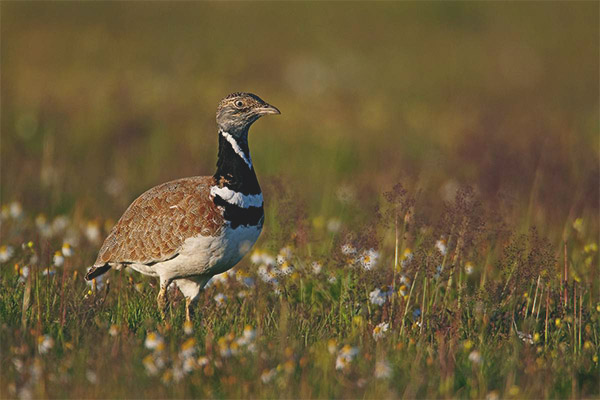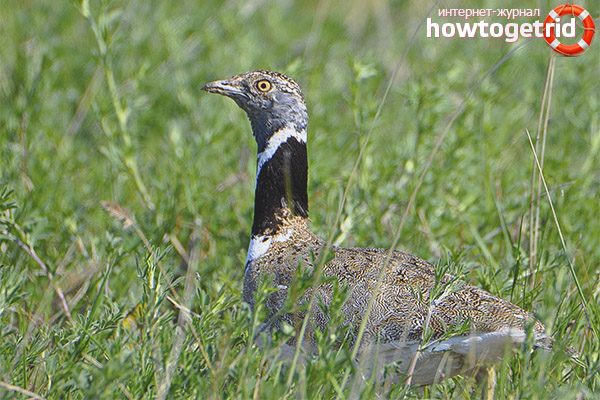The content of the article
Under the streptami are understood representatives of the family belonging to the bustards. Preferred habitats for individuals of this species are Asia, namely its western and central parts, Africa, and also the south of Europe. Birds settle in open steppe areas, by the nature of their stay they are sedentary. However, if some individuals live in cold climatic regions, they can go to warm lands for the winter. Since the plowing of the steppes has not been canceled, because of this, the population of individuals has declined significantly.
Habitat
Individuals of this breed group live in the southern part of Europe, according to the nature of their stay they can be migratory or sedentary. Much of it is spread across Africa, Asia and Europe. Birds live in dry pastures, in the steppe not marshland, and also in the meadows. It is possible to meet this breed in stony and feather grass zones.
Description
- Representatives of the family are famous for their large size. They are similar to individuals from the order of galliformes, but slightly larger. Along the length of the body, individuals grow up to 40-45 cm. As for body weight, these figures are in the range of 0.5-1 kg.
- Despite the relatively low weight, the birds are physically dense. They have a small head, an S curved neck, and also pointed wings. By the way, the scope of the latter ranges from 80-100 cm.
- Legs strong, medium in length, thin. The tail is wedge-shaped, short. Paws with three toes with sharp claws. This characteristic is peculiar to all members of the group.
- The bill is medium in length, but strong and straight. Sharpened on the tip. Feathers on the body are thick and moderately elongated. By color, the breed under discussion is similar to individual bustards. A back sand with dark outlines. The abdominal region is whitish.
- The neck is black, it has distinctive light stripes, which are arranged in a horizontal order. The upper part of the head is colored brownish, on the side there are blue with gray markings.
- The legs are beige, the beak is dark gray, the wings have plumage, the shade is slightly darker than the main format.Also on them is a black and white drawing.
Diet
- Individuals of this species are very active during the day. They start to get food when the sun rises, and finish late in the evening. If we are talking about cool days, the birds eat for a day. Can only come off to rest.
- If the mating season has not yet begun, these birds are knocked together in flocks of about 60 individuals each and such a large family lives up to the breeding season. If the winter is cold, then the number of individuals may pass for a hundred or even two.
- The daily ration includes equally the food of plant and animal origin. These birds love insects. From the vegetation choose roots, seeds, etc.
- Individual members of the group have a tendency to animal food. In such cases, about 70% of the diet are bugs, and only 30% is allocated to plant crops.
- Strepeta can live for a long time without water, because they get it by eating plants. In chicks, food is not as varied as in adults. Juveniles feed on invertebrates.
Breeding
- These birds find a mate and stay with it for a long time. If one of the family members dies, then after a while a new search for a satellite will begin. As for the marriage period, it originates from the middle or the end of spring.
- Males are extremely funny when they try to seduce females. They jump and quack interestingly, blow up feathers and shout loudly. At the same time, the sounds are deaf, understood only by the beautiful half of the feathered community. Because of such loud behavior, fights often arise, other males try to conquer their beautiful young ladies.
- Nesting is not up to par. Birds dig a hole under the bushes, after which the construction of a dwelling for future offspring begins. As a laying the female collects dry foliage or grass. The laying consists of five eggs, rarely when the expectant mother gives about ten. Hatching is done by two parents and lasts about 3 weeks.
- When the chicks are born, they are already covered with thick fluff. Literally in a few hours, they run after mom, who takes them to dense vegetation for security reasons. A month later, the younger generation makes the first attempts to start flying.
Interesting Facts
- A characteristic feature of the considered individuals is that the female is very tight on the eggs during laying. In this case, even in case of danger, the mother does not leave the nest. Because of this, such birds often die under agricultural equipment.
- The presented view is taken under protection for a relatively long time. In this case, the number of birds is still reduced, regardless of their habitat. At present, they are trying hard to breed strepes in Spain and France. In the northern areas of the birds are sometimes random. This is particularly true of England.
- Females from males can be easily distinguished. The latter have a larger size, bright color and the presence of a mustache. Females have a grayish tint. They have no whiskers and they are relatively small compared to males. The young growth is very similar to females, the color of the plumage is reddish and the whiskers appear only at 3 years.
- Such birds are characterized by a heavy takeoff. Therefore, the representatives in question rise into the air exclusively from the takeoff. The mating season begins in spring. Eggs are hatched only by a female. At this time, the males fly away in flocks to moult.
The birds in question are quite interesting individuals.They differ in silence from their relatives. Sometimes the voice of individuals can be heard only in the mating season and when the female calls for the young. With the appearance of the light, the chicks shout for a while, after that they become calm.
Video: strepta (tetrax tetrax)












To send